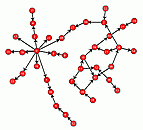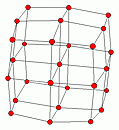Spring Embedding
Graphs can be used to represent relational information. This is the reason why it is often useful to draw graphs in order to visualize this relational information.
Spring Embedder are force directed layout algorithms. All edges are drawn as straight lines.
Force directed layout algorithms model the input graph as a system of forces and try to find a minimum energy configuration of this system.
The idea of spring embedders is to simulate the graph as a system of mass particles. The nodes are the mass particles and the edges are springs between the particles. The algorithms try to minimize the energy of this physical system.
LEDA Functions for Spring Embedders
SPRING_EMBEDDING(): Let G=(V,E) be a
graph. SPRING_EMBEDDING() computes a spring embedding of
G in the plane. In the resulting drawing edges may cross
even if the graph is planar. It is also possible that edges cross nodes.
D3_SPRING_EMBEDDING(): Let G=(V,E) be
a graph. D3_EMBEDDING() computes a spring embedding of G
in 3D.
Tip
The best results of spring embedding are obtained for sparse, tree-like graphs.
See also:
Manual Entries:
Manual Page Graph Drawing Algorithms

